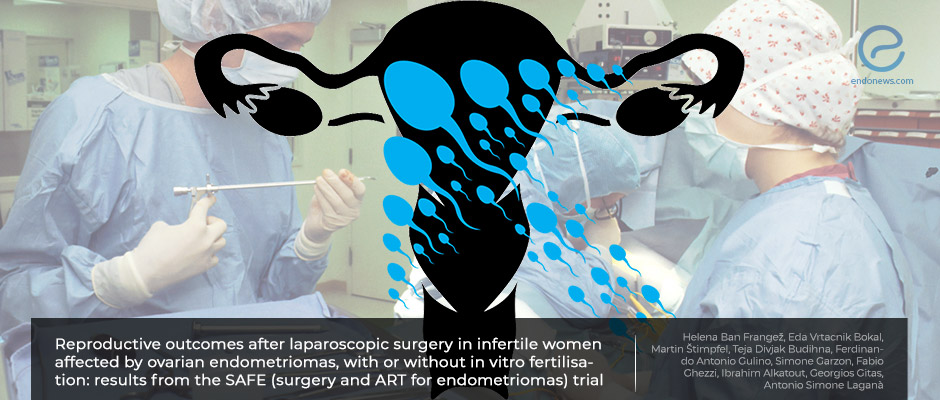Impact of surgery before IVF in infertile women with endometrioma
Oct 28, 2021
Surgical removal of ovarian endometrioma before in vitro fertilization does not change pregnancy and delivery rates despite the need for higher doses of gonadotropins for ovarian stimulation and a lower number of retrieved oocytes.
Key Points
Highlights:
- Reproductive outcomes and ovarian stimulation parameters do not differ between endometriosis patients and those with other types of infertility, especially in older women.
Importance:
- Other than the size of endometrioma, the presence of symptoms besides infertility failed therapies for symptom control or ART, age, and ovarian reserve of the patients should be determinants for the management of infertility.
What’s done here?
- A retrospective cohort study, from the “Surgery and ART for Endometriomas” trial was conducted to compare reproductive outcomes between the patients with endometriosis and other reasons for infertility.
- A group with laparoscopic endometrioma cystectomy by senior surgeons before in vitro fertilization (IVF), compared to other groups (unexplained infertility, male factor infertility, and tubal factor infertility).
- The main outcome measures were hormone values (follicle-stimulating hormone and luteinizing hormone) before IVF procedure, gonadotropin dose used for ovarian stimulation, number of retrieved oocytes, number of obtained embryos, pregnancy and delivery rates.
Key results:
- A total of 1696 cycles from 765 patients were evaluated, with 256 women being in the laparoscopic endometrioma surgery group.
- The postoperative mean FSH and LH values before IVF were significantly higher in the patients who were operated on for endometrioma, compared to other groups.
- Higher doses of gonadotrophins during ovarian stimulation were needed in the endometrioma group, however, this significant difference was lost with the increasing age.
- The number of oocytes retrieved after ovarian stimulation was significantly lower in the endometrioma group, and similarly, this significance was attenuated in the older age group.
- The number of embryos developed, embryo utilization, pregnancy, and delivery rates were comparable between the groups.
Strengths and Limitations:
- Being the first study in which all women were operated on before the IVF procedure to restore anatomical distortions and allow spontaneous conception was the strength of the study.
- Retrospective design, absence of anti-mullerian hormone comparison, or preoperative-postoperative comparison are the limitations.
Lay Summary
Among the women with endometriosis, 30 to 50% are estimated to have infertility. On the contrary, among women who present with infertility, 25 to 50% are estimated to also have endometriosis. Several mechanisms have been proposed to explain the association between endometriosis and infertility, including anatomic distortion, diminished tubal peristalsis, diminished sperm movements, dysfunctional folliculogenesis, luteal phase dysfunction, alterations in endometrial receptivity.
Although the most common treatment modalities for infertility in endometriosis patients are surgical removal of endometriomas and/or IVF procedures, individualization of the treatment is the most appropriate approach.
Frangež et al, from Slovenia, Italy, and Germany, published a study titled “Reproductive outcomes after laparoscopic surgery in infertile women affected by ovarian endometriomas, with or without in vitro fertilization: results from the SAFE (surgery and ART for endometriomas) trial” in the Journal of Obstetrics and Gynaecology. The authors aimed to evaluate reproductive outcomes in infertile patients with endometriosis who were operated on before IVF compared to other types of infertility. They assessed FSH and LH levels before the IVF procedure, gonadotropin dose used for ovarian stimulation, and the number of retrieved oocytes.
There was no significant difference regarding the number of embryos developed, embryo utilization, pregnancy, and delivery rates although higher doses of gonadotropins for ovarian stimulation were used and a lower number of oocytes were retrieved in endometriosis patients compared to other reasons of infertility. However, when the participants were analyzed based on the age stratification, the statistical significance was lost with the increasing age.
“Adequate counseling about reproductive outcomes for infertile women with ovarian endometriomas and allow a proper decision-making approach shared with the patient.” the authors added.
Research Source: https://pubmed.ncbi.nlm.nih.gov/34585638/
endometriosis laparoscopic surgery in vitro fertilization reproductive outcomes age stratification

